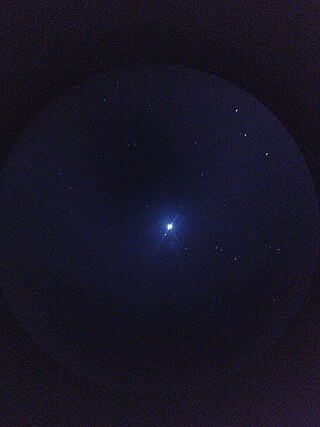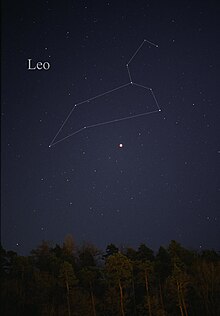Regulus (star)
|
Multiple star Regulus (α Leonis A) |
|||||||||||||||||||
|---|---|---|---|---|---|---|---|---|---|---|---|---|---|---|---|---|---|---|---|

|
|||||||||||||||||||
| Regulus in the constellation Leo | |||||||||||||||||||
| AladinLite | |||||||||||||||||||
|
Observation dates equinox : J2000.0 , epoch : J2000.0 |
|||||||||||||||||||
| Constellation | lion | ||||||||||||||||||
| Right ascension | 10 h 08 m 22.31 s | ||||||||||||||||||
| declination | + 11 ° 58 ′ 2 ″ | ||||||||||||||||||
| Apparent brightness | 1.36 mag | ||||||||||||||||||
| Typing | |||||||||||||||||||
| B − V color index | −0.11 | ||||||||||||||||||
| U − B color index | −0.36 | ||||||||||||||||||
| R − I index | −0.10 | ||||||||||||||||||
| Spectral class | B7 V | ||||||||||||||||||
| Astrometry | |||||||||||||||||||
| Radial velocity | (5.9 ± 2.4) km / s | ||||||||||||||||||
| parallax | (41.13 ± 0.35) mas | ||||||||||||||||||
| distance | (79.30 ± 0.67) Lj (24.31 ± 0.21) pc |
||||||||||||||||||
| Visual absolute brightness M vis | −0.57 mag | ||||||||||||||||||
| Proper movement | |||||||||||||||||||
| Rec. Share: | (−248.73 ± 0.35) mas / a | ||||||||||||||||||
| Dec. portion: | (5.59 ± 0.21) mas / a | ||||||||||||||||||
| Physical Properties | |||||||||||||||||||
| Dimensions | (3,4) M ☉ | ||||||||||||||||||
| radius | (3.24 ± 0.28) R ☉ | ||||||||||||||||||
| Luminosity |
(150) L ☉ |
||||||||||||||||||
| Effective temperature | (12500) K | ||||||||||||||||||
| Rotation time | 16 h | ||||||||||||||||||
| Age | (250) mill. A | ||||||||||||||||||
|
Other names and catalog entries |
|||||||||||||||||||
|
|||||||||||||||||||
| annotation | |||||||||||||||||||
|
|||||||||||||||||||
Regulus ( Bayer name : α Leonis ) is the brightest star ( main star ) in the constellation Leo . The Latin name means Little King or Prince ( diminutive of Rex ). Regulus forms the spring triangle together with the stars Arktur and Spica .
Regulus is 79 light years away from the sun and has an apparent magnitude of 1.36 mag with an absolute magnitude of −0.2 mag. It belongs to the spectral class B7.
As a star near the ecliptic, Regulus is often covered by the moon and very rarely also by the planets Mercury and Venus . The occultations by the moon occur in groups that alternate at intervals of 8.7 and 9.9 years. The group from December 2016 to April 2018 is followed 8.7 years later by a group that extends from July 2025 to December 2026 (from a given location, however, only a small part of this cover is visible). The last occultation of Regulus by a planet was on July 7, 1959 by Venus, the next one will be again on October 1, 2044 by Venus. Coverings of the Regulus by other planets are not possible for the next few millennia due to their current orbital position. On March 20, 2014, Regulus was covered by the asteroid (163) Erigone , which could only be observed in a narrow strip over the North Atlantic and North America (including from New York City ).
Other names are Qalb al-Asad with the same meaning as Cor Leonis ("Heart of the Lion"). Modified forms of the Arabic name are Kabeleced, Kalb and Kelb. Rex, meaning king, is yet another name. Regulus is also known as one of the four Persian royal stars.
See also
Web links
Individual evidence
- ↑ a b c Hipparcos catalog (ESA 1997)
- ↑ a b c Bright Star Catalog
- ↑ Pulkovo radial velocities for 35493 HIP stars
- ↑ a b c Hipparcos, the New Reduction (van Leeuwen, 2007)
- ↑ a b c d Regulus. Jim Kaler, accessed September 1, 2019 .
- ↑ a b JMMC Stellar Diameters Catalog - JSDC (Lafrasse +, 2010) (calculated from the data values LDD and Plx)
- ^ J. Meeus: Mathematical Astronomy Morsels. Willmann-Bell, Richmond 1997, ISBN 0-943396-51-4 , p. 115
- ^ J. Meeus: Mathematical Astronomy Morsels. Willmann-Bell, Richmond 1997, ISBN 0-943396-51-4 , p. 125
- ^ GP Kann, J. van Maanen: Planetary occultations of bright stars. Journal of the British Astronomical Association, Vol. 91, pp. 148-157, Table 2 ( digitized ).
- ↑ Pierpaolo Ricci: Occultations of Bright Stars by Planets from the Year 0 to 4000. Retrieved September 21, 2017 .
- ↑ Occultation of alpha Leo (Regulus) by 163 Erigone on 03/20/2014. Predicted ground track with estimated uncertainties. ( Memento of the original from August 13, 2011 in the Internet Archive ) Info: The archive link was inserted automatically and has not yet been checked. Please check the original and archive link according to the instructions and then remove this notice.

